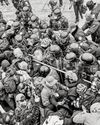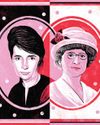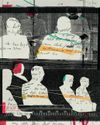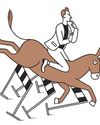
The hired gunman in Ernest Hemingway’s 1927 short story “The Killers”—who, when asked “What’s the idea?,” answers, “There isn’t any idea”—is a primordial counterpart to the guard in Auschwitz who told the inmate Primo Levi, “Here there is no why.” Instead of filling in these blanks, filmmakers have tended to welcome them. Thus, like the movie Nazi, the hit man has become so emptied of substance as to be, with rare exceptions, a ponderous cliché—a deadly bore.
A prime virtue of Richard Linklater’s new film, “Hit Man,” is that it features no hit man. Rather, it’s centered on a character who portrays a hit man—an actor, in a sense, albeit one whose masquerade has nothing to do with entertainment. Linklater, faced with a plethora of precursors and stereotypes, leans into them with a diabolically smart yarn about illusion and imagination—less the psychology of the hit man than the psychology of the myth of the hit man. His comedic approach gets deeper into the archetype, by way of mere talk about violence, than many similar movies do with the grim depiction of gore. What’s more, the film is also a romantic comedy, among the cleverest and most resonant recent examples of the genre.
This story is from the June 10, 2024 edition of The New Yorker.
Start your 7-day Magzter GOLD free trial to access thousands of curated premium stories, and 9,000+ magazines and newspapers.
Already a subscriber ? Sign In
This story is from the June 10, 2024 edition of The New Yorker.
Start your 7-day Magzter GOLD free trial to access thousands of curated premium stories, and 9,000+ magazines and newspapers.
Already a subscriber? Sign In

GET IT TOGETHER
In the beginning was the mob, and the mob was bad. In Gibbon’s 1776 “Decline and Fall of the Roman Empire,” the Roman mob makes regular appearances, usually at the instigation of a demagogue, loudly demanding to be placated with free food and entertainment (“bread and circuses”), and, though they don’t get to rule, they sometimes get to choose who will.

GAINING CONTROL
The frenemies who fought to bring contraception to this country.

REBELS WITH A CAUSE
In the new FX/Hulu series “Say Nothing,” life as an armed revolutionary during the Troubles has—at least at first—an air of glamour.

AGAINST THE CURRENT
\"Give Me Carmelita Tropicana!,\" at Soho Rep, and \"Gatz,\" at the Public.

METAMORPHOSIS
The director Marielle Heller explores the feral side of child rearing.

THE BIG SPIN
A district attorney's office investigates how its prosecutors picked death-penalty juries.

THIS ELECTION JUST PROVES WHAT I ALREADY BELIEVED
I hate to say I told you so, but here we are. Kamala Harris’s loss will go down in history as a catastrophe that could have easily been avoided if more people had thought whatever I happen to think.

HOLD YOUR TONGUE
Can the world's most populous country protect its languages?

A LONG WAY HOME
Ordinarily, I hate staying at someone's house, but when Hugh and I visited his friend Mary in Maine we had no other choice.

YULE RULES
“Christmas Eve in Miller’s Point.”